Longines RR280 , the Canadian Pacific Railways approved wristwatch, so-called the “Canadian”
Premise
One of the less known Longines professional watches is the RR280.
A professional wristwatch produced for Canadian Pacific Railroad (and Canadian National )during the 60es that is showing very peculiar dial , movement and case.
Few models went throught the vintage watches collector’s community.
It is necessary to explore both , the Railroad world and the watch information coming from the past in order to understand the importance of this railroad wristwatch and its fantastic world.
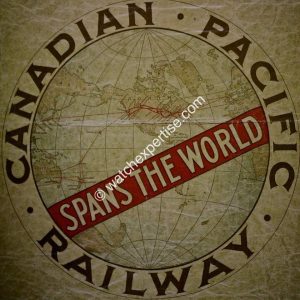
PHOTO (CPR SPANS THE WORLD) 1
The C.P. Rail Story
“the story of the Canadian Pacific Railway is largely the story of modern Canada” Mr. E.W.Beatty , Chairman and President of C.P.Rail , said in his preface of the book about the history of his Company. In fact Canadian development is directly connected to the expansion of its railway. The railways construction started at the end of 19th Century . CPR was connected to other American railways and they were sharing all technical developments and rules.
With 14 thousand of track’s miles the giant was and still is a public shares company .
Since the beginning the simple raolroad activity of CP Rail expanded the business to maritime transportation , telegraph service , hotels chains (Fairmont Hotels) and airlines companies (Canadian Airlines ).
For coordinating the activity of thousands of employees , railmen and trains, it was necessary to adopte standards and rules about time control.
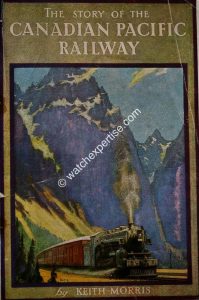
PHOTO (CPR) 2
The Standard Time, the inventor and the adoption
At the start of railroading in U.S. and Canada, no standard time was considered. Every city, town and railroad had their own standard time.
The CPR was always a champion of accurate timekeeping. We have to note that it was Sir Sanford Fleming , the CPR Chief Engineer and the man who surveyed the route of Rocky Mountains , the inventor of the “ Worldwide Standard Time” published on February 8th 1879.
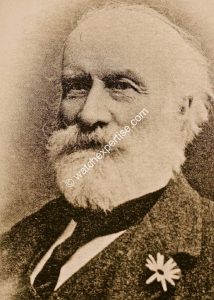
PHOTO (Sir Fleming) 3
North American and Canada Railroads started the concept of Standard Time in May 1872, when the Association of Railroad Superintendents, a forerunner of Association of American Railroads, met in the Southern Hotel in St. Louis.
The meeting was scheduled for the purpose of setting the summer passengers schedules. This results grew out to reach “the time table convention” during the General time convention on October 1883 when Mr. William F. Allen presented his 4 zones system. It was approved unanimously.
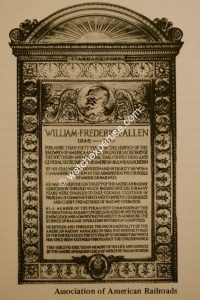
PHOTO (lapide Allen) 4
The following November 8th 1883 almost 600 railroad lines dropped the 53 arbitrary time they were using and adopted the Greenwich indexed meridians that defined the times in each of the four new time zones (Eastern;Central;Mountain and Pacific). The biggest American and Canadian cities followed the railroad lead , adopting zone time for their own uses (the Canadian Maritime provinces were in a fifth zone , Intercolonial Time). On March 1918 Four times zones were approved by the US Congress.
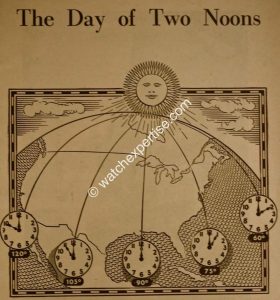
PHOTO ( 4 Time Zones) 5
The events and protagonist of the timekeeping standardization adoption
On April 19 , 1891 a smoldering disaster happened near Cleveland , Ohio . That morning the fast mail train n.4 and a passenger train n.21 were going on the opposite direction on the same track. It was near Elyria , 25 miles away from Cleveland , despite the engineer and the conductor of the passenger train got written orders to stop and left fast train to pass, when the passenger train left the Elyria station the engineer did not noticed that his watch was stopping and starting again with a gap of 4 minutes. At Kipton station the two trains made a collision , the passenger train full braking, the fast mail at its full speed. The two engineers died together with other nine people. The two rail companies, Lake Shore Railroad and Michigan Southern Railways , sustained heavy losses as well as U.S.Post Office.
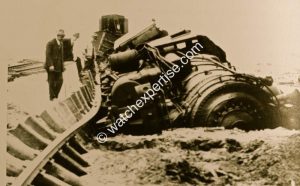
PHOTO (accident) 6
During the trial of Lake Shore incident it was nominated as expert witness Mr. Webb C. Ball, a known jeweller from Cleveland, Ohio. The passenger’s train engineer was wearing a cheap alarm watch. Mr. Ball was authorized to investigate the watch situation on the Lake Shore Lines, and to set up a watch inspection system. The major railroads at that time recognized the importance of watch standardization and watch inspection system. Mr. Ball was appointed as General Watch Inspector for many North American , Canadian and Mexican Railroads since then he became the general time inspector for over 125,000 miles of railroad. He established later his own watch company.

PHOTO AD BALL watch 7
Finally railroads set up the Time Service Department based on the system invented by Mr. Ball.
The standardization
The general Railroad timepiece standards has been adopted since 1893 and any watch used in rail service by railroaders responsible for schedules must meet the following mechanical standards:
“be open face , size 18 or 16, have a minimum of 17 jewels, adjusted to minimum 5 positions , adjusted to temperatures of 34 to 100 degres Farhenheit (-1 to +38 grade centigrade), steel escape wheel , lever set , micrometric regulation, Lépine caliber”. Some Railroads wanted Breguet hairspring , adjusted to isochronism and 30 degree Farhenheit and minimum of 19 jewels.
The following requirements for railroad approved watches were set by Mr. R.D. Montgomery , General Inspector of Santa Fé Railway system during 1930 :
“The regulation watch designated as of 1930 to be standard is described as follows: 16 size , American, lever-setting,19 jewels or more, open face, winding at “12”,double-roller escapement, steel escape wheel, adjusted to 5 positions, temperature and isochronism, which will rate within a variation not exceeding 6 seconds in 72 hours tests, pendant up, dial up and dial down, and to be regulated to run within a variation not exceeding 30 seconds per week”.
Mainly Canadian Pacific (and CN later) approved Swiss watches both pocket and wrist ones. US Railroads listed majority American watche due a policy of “buy American”. In fact into the Form 7528 edited by Union Pacific Railroad Company effective on July 1946 , valid for the entire Easten and South-Central RR District , the art.35 Watch Standards says : “The minimum standard for excellence for watches now in service shall be an American movement “.
Some exceptions are known , The evidence that US Railroads was using Longines pocket watches is contained in the Wittnauer Materials catalog dated 1911. According to E.Ueberall&Singer in their article “the railroader’s corner” published on October 1988 by Nawcc bulletin the serial numbers of railroad Express Monarch and Express Leader fell between 950,000 and 3millions. Very impressive!
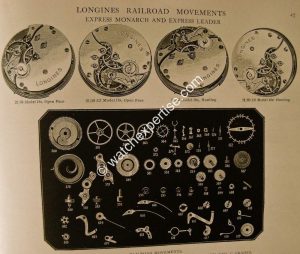
PHOTO CATALOG WITTNAUER 1911 8
Another exception is the T905 Longines , the other so called “railroad wristwatch” with a different dial and adjusted on 3 positions , isochronism and temperature, that was approved by United Pacific Railways (according to Larry Treiman in his fantastic article “The interesting Story of Railroad watches and Service Time” edited by National Railway Bulletin volume 41 , number1 , 1976. The reference is the same as for Canadian (7186) but first bunch -1. The dial and the main movement bridge are not marked RR280 and this is confirmed by Longines archives.
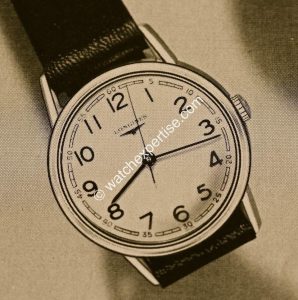
PHOTO Catalogo Longines 1964 9
The railroad men were compelled to buy timepieces approved by Railroads on their own costs. At CPR the cost was deducted monthly from salary in three months installments.
According to controls and regulations if the watch fell behind or gained 30 seconds in 7 or 14 days it was required to be submitted for overhauling or reparation. Small cards were given to the engineers and conductors, the railroad timekeepers and a complete record of the watch’s performances were written in ink.
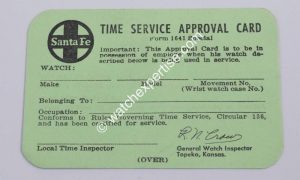
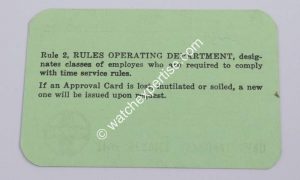
PHOTO CARD 10
All repairs , overhauling and adjustments were made by approved and experienced watchmakers. All the time keeping activity was subject to inspection by authorized inspectors. Every 180 days CPR was requesting service (lately every 90 days , the most strict rules). When the watch was under service , the CPR used to supply to his employees a temporary watch so called “the loaner”. Watches were numbered and marked “Loaner” on the back case. In case of missed return the cost of the watch was charged to the employee.
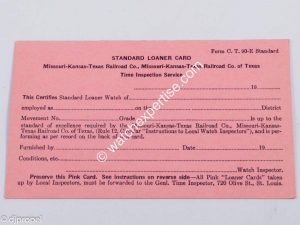
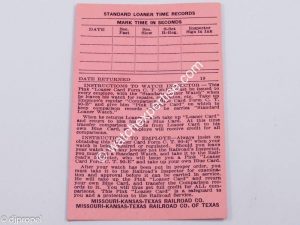
PHOTO Loaner card 11
The standard RR and Canadian dials.
When first standards were adopted in 1893, the rules about dial were saying:
“Use plain Arabic numbers printed bold and black on a white dial and have bold and black hands”.
The first dial design patended in US was the Ferguson dial.
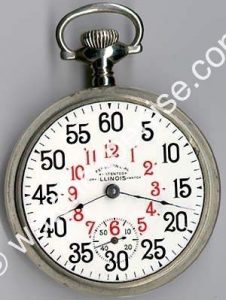
PHOTO (FERGUSON DIAL) 12
It never became very popular due its not easy readibility. In 1920 the Montgomery dial appeared , the patent history went lost and not so many information are available. Between collectors only the stamped “Montgomery Safety dial Co” tends to be considered the original one.
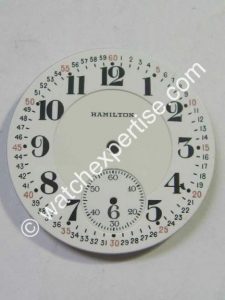
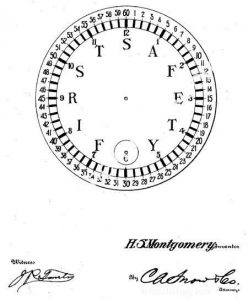
PHOTO (MONTGOMERY DIAL) 13
It was an innovating dial and many Railways adopted and promoted it despite Mr. Ball took legal action against it. He affirmed only his dials were the approved ones. All the others were not safe in his opinion.
The Ball standard dial
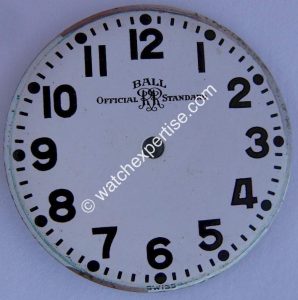
PHOTO (BALL DIAL) 14
According to the Ball standard rules this one was the only “approved” dial and the most clean reading one.
When we talk about the “Canadian dial” we have to take a step back in the history. CPR ,the most developed Railway at that time , adopted the concept of “standard dial” in 1883 , when the 24 hours dial was required in all watches used in the company service. Since that moment the double arabic numbering with internal arabic indexes with 24-13 hours (early black than lately red) is so-called “Canadian dial” or “Canadian railroad”.

PHOTO (CANADIAN DIAL) 15
The main index could be bold black arabic or Roman. The same dial was adopted by CN Railways. Canadian Nationa Railways adopted also another version so called “0-” where the hour indexes were starting from 0-11 and internally 12-23. Really a couple of Longines RR280 appeared with -0 dial , all of them are not carrying a RR280 movement with fine regulation and fine adjustments. It looks like dials were printed for CN Railways but sales did not succeed. The few dial around probably have been recased.
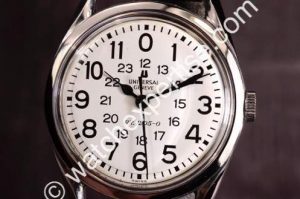
PHOTO (CN dial example of Universal RR1205-0) 16
Longines and Canadian Pacific Railways
The business relationship between CPR and Longines has deep roots. The American sister company Longines-Wittnauer was the exclusive agent for US and Canada since 1876 and it was established a direct corporation company in Canada since 1937.
The fine pocket watches Longines Express Monarch and Express Leader were approved in the first CP Railways list on October 1 ,1899 and in the second one on July 1 , 1928 (once approved the models remained valid, new lists were only adding approved watches).
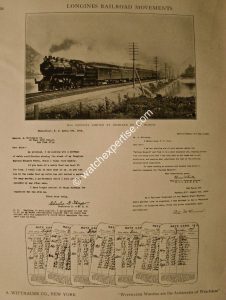
PHOTO CAT. WITTNAUER 1911 17
The wristwatch list whith all approved brands and models is not known when it was published but we can say around 1960 (the last addition on approved pocket watches is dated 1957).
In the list we can find more brands : Cyma , Girard Perregaux, Universal and Zenith .Also RR280 Longines is included in the list.
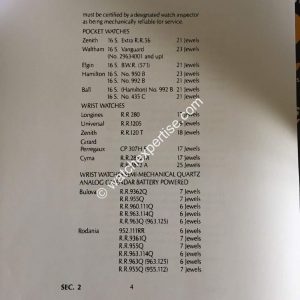
PHOTO ARTICOLO SU RR 18
The Longines RR280 references 7186 and 8303 must be considered a peculiar production for Canadian Pacific Railroad. We have to stress also that CN Railways approved and adopted RR280. Longines archives are mentioning a single lot dated 1969 , destination Wittnauer Canada, the only one carrying the RR 280 on dial and movement.
Longines RR280 in details
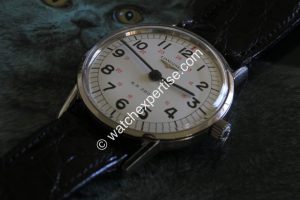
PHOTO of RR280 19
The “Canadian” ref.7186 is not very known between collectors. Due to its 60es look and the 35 mm thin case many collectors are not taking it seriously as one of the best Longines wristwatches ever made. Done earlier in the “American” version indicated as T905 Longines Railroad watch , it was sold in 1964 at 115 USD on leather strap (10 USD less than the Skin Diver two crowns).
The watch reference 7186 made in 5 bunches of production (7186-1;-2;-3 ;-4;-5). The higher number of cases found is numbered 241. If we consider the Longines period and the CP Railways requests (in 1957 Zenith produced in total 1700 pocket of its pocket watches RR-56) we can assume 300 to 500 pieces per lot having 900 to 1500 RR280 total pieces manufactured. My personal opinion is that production can be considered less than thousand.
The second reference , following the 7186 , is the 8303 steel with gold bezel . Extremely rare.
Reference 7186 and 8303 description :
.The case
In stainless steel monoblock waterproof , antimagnetic with screwed back is the same used for Jamboree model (Launched in Basel in 1959). 35 mm. diameter , the height without plexi is 5.58 mm. with plexi it reaches 8,65 mm. Anyway very thin. Internally a copper gasket is giving tight waterproofing. The plexi is equipped with a tension ring as per specification. The crown is waterproof with Longines logo diam. 5 mm. The back case has 6 rectangular notches for a specific opening key . Many times heavy scratches are left on the back case due to not proper opening tools. On the back case the external part the movement serial number is engraved. It is a light engraving that sometinmes is buffet out by polishing the case. The case is fully polished , only between notches an anular satin ring is brushed.
Inside the back case we find stamped:
Longines watch&co – stainless steel – ref.7186-(1;2;3;4;5) and case number.
Lugs are faceted , slim and elegant, easy to be ruined by hits. The case is in general elegant and thin according to the design period tendences. Case Production is not in-house (La centrale SA/Hubert manufacturers) .The reference 8303 has a 14kt gold bezel , gold plated crown ,the only two differences compared to ref.7186, this is an example appeared on the Internet years ago .

PHOTO RR280 8303 20
.The dial
The dials of RR280 ref. 7186 and 8303 are white matt lacquered (version 11-695), “façon émail “(enameled look), with back side stamped R and star indicating Stern manufacturer and 71 client’s numbering (Longines).
The face of the dial shows 5th outer capiter ring scale with thicker index every 5 minutes and thin lines for internal minutes , it has a red space stressing 12 o’clock. Below applied white gold Longines logo with above written Longines, at 6 o’clock written R.R.280 capital letters and dots. Swiss at 6 o’clock within the chapiter ring. Internal red numbering 24/13 (24 hours) according to CP Rail standards.
A 100% Canadian dial.
In the reference 8303 the applied logo Longines is yellow gold matching the 14kt bezel.
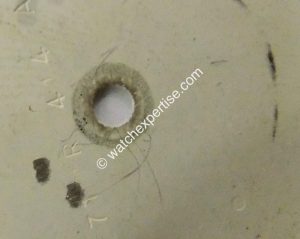
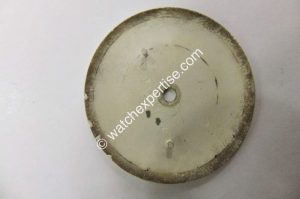
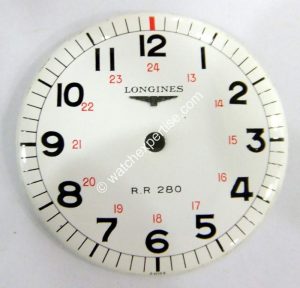
PHOTO rr280 7186 21
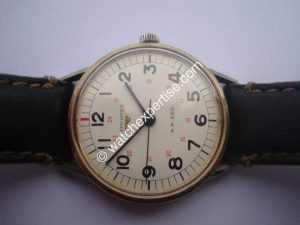
PHOTO rr280 8303 22
The 7186 , earlier version called T-905 for American market and listed at Union Pacific Railways, have a different dial , not “Canadian”, it has Arabic indexes 12/11 , Arabic numbers stressing every 5 seconds from 5 to 60 and an interrupted chapiter ring with 3 second extension. Applied Longines logo. No RR280 marking on dial. In Longines archives is only mentioned as ref.7186.
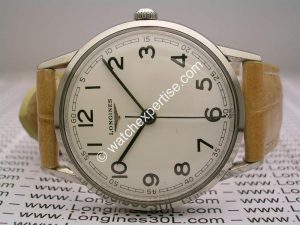
PHOTO of T905 23
The material of the dial plate could be amagnetic (not significant differences of weight between RR280 and other similar dials- all between 11and 13 gr). The 1964 “Centennial” catalog says “antimagnetic shield under dial 5 times more effective than a conventional antimagnetic watch” .
.The hands
The references 7186 and 8303 hands are baton rounded black , easy readible , neat. The sweep seconds hand is thin line shape with tale, 13 mm , Thin but readible.
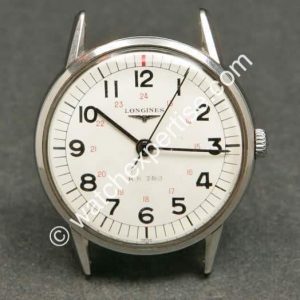
PHOTO of RR280 hands 25
In both references there is another version dial reference 11-696 where the hands , called “Pacific” are very nice and attractive , dual standard time , one black and one red for time zones crossing. The two colors are split by a gilt partition. The minutes hand is baton thick black. The sweep second hand is the same as in the previous versions. This kind of “Pacific” hands were required for employees operating in two time zones.
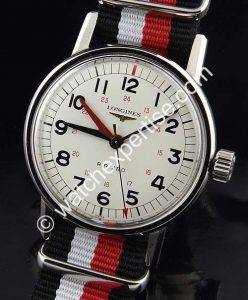
PHOTO of Pacific hands 26
The 7186 T905 model carries the same type of hands. Let us call him the “American Railroader”.
.The movement
Based on the 1959 launched 280 caliber the RR280 has 11 and ¾ size (26,5mm D and 4,3 mm H), pallet fork – 17 jewels
W.p.h. 19800
Adjusted to 5 position (model T905 adj. 3 positions ,temperature and isochronism- it wasn’t marked RR280 on central bridge , just 280 ).
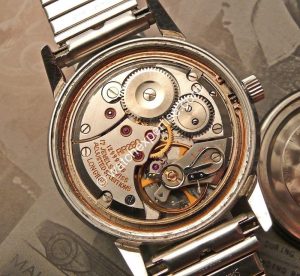
PHOTO RR280 Movement 27
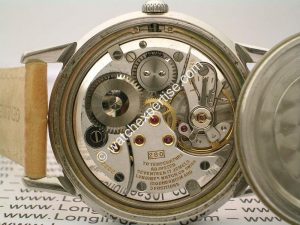
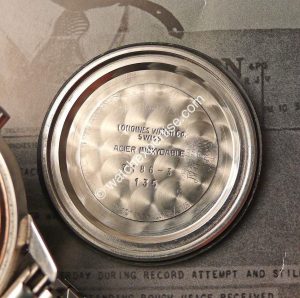
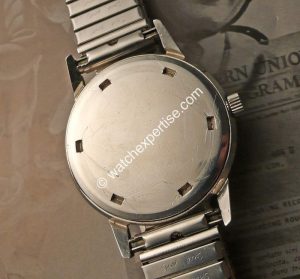
PHOTO T905 movement 28
Stop second device . Pulling the crown is stopping the balance wheel and you can set the time to second.
Balance wheel “annulaire” in Glucydur antimagnetic without compensating screws. Breguet spring.
Swan neck micrometric adjustment.
Different bridges and separate spare parts list.
The Longines RR280 (as well as T-905) is a very refined wristwatch with performances according to RR Standards with same level of accuracy of a chronometer certified by COSD.
.The advertisement
The only available advertisement for the Railroad Longines is the Centennial Longines-Wittnauer dated 1964 and with limited edition numbered 2541. The T905 model is showed.
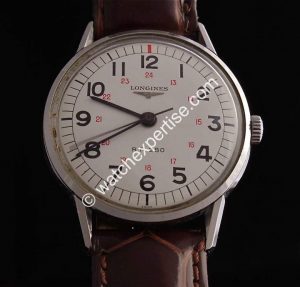
PHOTO 29
.The specific spare parts file
From the Longines Book n.10 for spare parts we found the specific list of spare parts belonging to RR280 where the bridge ref.110 shows the vertical engraving RR280.
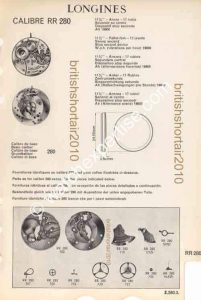
PHOTO 30
.Conclusion
Longines produced specifically for the Canadian railways (CP mainly and CN) the RR280 watch (ref.7186 and 8303). Really few RR280 are nowadays available for collectors. Personally I’ve admired no more than 3/4 pieces in good order and a couple with reprinted dials in more than 20 years of collecting.
The value of the watch is under estimated . The RR280 is a fantastic example of Longines high manufaturing quality level (one of the last examples) where all details and movement created an iconic and professional working tool for CPR (and CN) technical personnel able to coordinate trains in a impeccable and secure way for many years.
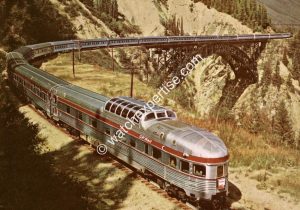
PHOTO of Rr280 pacific hands 31
.Credits
Longines Museum , Ms Jennifer Bochud- Curator
www.Vintagewatchestobuy.com , vintage watches in London Canada
www.longines30L.com , Norway
www.Lorologiese.com vintage time pieces Switzerland
www.Senzatempo.info vintage watches Italy
Antica Orologeria Zamberlan , www.orologeria.com Italy
.Bibliography
NAWCC bulletin October 1998/December 1997
Wittnauer – A History of the Man & His Legacy
Cooksey Shugart & Tom Engee Official Guide to Watches
Day of two noons – Carlton Corlis 1956
Catalog spare parts n.7 Longines wittnauer dated 1911
Catalog spare parts n.10 Longines 1970
Centennial Catalog Longines 1965
Time Lord – Clark Blaise 2002
The story of Canadian Pacific Railways-Morris,Keith 1931
The spiral Tunnels and big hill- Graeme Pole 1999
National Railway Bulletins 1976-1983
Railroad History spring 1983
CP Rail General Operating Instructions 1986
Union Pacific RC form 7528 July 1946
Train Wrecks by Robert C. Lee 1960